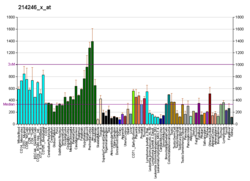Misshapen-like kinase 1 is an enzyme that in humans is encoded by the MINK1 gene.
Function
Misshapen-like kinase 1 is a serine/threonine kinase belonging to the germinal center kinase (GCK) family. The protein is structurally similar to the kinases that are related to NIK and may belong to a distinct subfamily of NIK-related kinases within the GCK family. Studies of the mouse homolog indicate an up-regulation of expression in the course of postnatal mouse cerebral development and activation of the cJun N-terminal kinase (JNK) and the p38 pathways. Alternative splicing occurs at this locus and four transcript variants encoding distinct isoforms have been identified.
Interactions
MINK1 has been shown to interact with NCK1.
References
- ^ GRCh38: Ensembl release 89: ENSG00000141503 – Ensembl, May 2017
- ^ GRCm38: Ensembl release 89: ENSMUSG00000020827 – Ensembl, May 2017
- "Human PubMed Reference:". National Center for Biotechnology Information, U.S. National Library of Medicine.
- "Mouse PubMed Reference:". National Center for Biotechnology Information, U.S. National Library of Medicine.
- Dan I, Watanabe NM, Kobayashi T, Yamashita-Suzuki K, Fukagaya Y, Kajikawa E, Kimura WK, Nakashima TM, Matsumoto K, Ninomiya-Tsuji J, Kusumi A (Mar 2000). "Molecular cloning of MINK, a novel member of mammalian GCK family kinases, which is up-regulated during postnatal mouse cerebral development". FEBS Letters. 469 (1): 19–23. doi:10.1016/S0014-5793(00)01247-3. PMID 10708748. S2CID 39793431.
- Dan I, Watanabe NM, Kajikawa E, Ishida T, Pandey A, Kusumi A (Jul 2002). "Overlapping of MINK and CHRNE gene loci in the course of mammalian evolution". Nucleic Acids Research. 30 (13): 2906–10. doi:10.1093/nar/gkf407. PMC 117062. PMID 12087176.
- ^ "Entrez Gene: MINK1 misshapen-like kinase 1 (zebrafish)".
- Hu Y, Leo C, Yu S, Huang BC, Wang H, Shen M, Luo Y, Daniel-Issakani S, Payan DG, Xu X (Dec 2004). "Identification and functional characterization of a novel human misshapen/Nck interacting kinase-related kinase, hMINK beta". The Journal of Biological Chemistry. 279 (52): 54387–97. doi:10.1074/jbc.M404497200. PMID 15469942.
Further reading
- Bonaldo MF, Lennon G, Soares MB (Sep 1996). "Normalization and subtraction: two approaches to facilitate gene discovery". Genome Research. 6 (9): 791–806. doi:10.1101/gr.6.9.791. PMID 8889548.
- Wistow G, Bernstein SL, Wyatt MK, Fariss RN, Behal A, Touchman JW, Bouffard G, Smith D, Peterson K (Jun 2002). "Expressed sequence tag analysis of human RPE/choroid for the NEIBank Project: over 6000 non-redundant transcripts, novel genes and splice variants". Molecular Vision. 8: 205–20. PMID 12107410.
- Gevaert K, Goethals M, Martens L, Van Damme J, Staes A, Thomas GR, Vandekerckhove J (May 2003). "Exploring proteomes and analyzing protein processing by mass spectrometric identification of sorted N-terminal peptides". Nature Biotechnology. 21 (5): 566–9. doi:10.1038/nbt810. PMID 12665801. S2CID 23783563.
- Campdelacreu J, Ezquerra M, Muñoz E, Oliva R, Tolosa E (Apr 2003). "Mutational study of the nuclear factor kappa B inducing kinase gene in patients with progressive supranuclear palsy". Neuroscience Letters. 340 (2): 158–60. doi:10.1016/S0304-3940(03)00105-8. PMID 12668260. S2CID 45355312.
- Beausoleil SA, Jedrychowski M, Schwartz D, Elias JE, Villén J, Li J, Cohn MA, Cantley LC, Gygi SP (Aug 2004). "Large-scale characterization of HeLa cell nuclear phosphoproteins". Proceedings of the National Academy of Sciences of the United States of America. 101 (33): 12130–5. Bibcode:2004PNAS..10112130B. doi:10.1073/pnas.0404720101. PMC 514446. PMID 15302935.
- Hu Y, Leo C, Yu S, Huang BC, Wang H, Shen M, Luo Y, Daniel-Issakani S, Payan DG, Xu X (Dec 2004). "Identification and functional characterization of a novel human misshapen/Nck interacting kinase-related kinase, hMINK beta". The Journal of Biological Chemistry. 279 (52): 54387–97. doi:10.1074/jbc.M404497200. PMID 15469942.
- Olsen JV, Blagoev B, Gnad F, Macek B, Kumar C, Mortensen P, Mann M (Nov 2006). "Global, in vivo, and site-specific phosphorylation dynamics in signaling networks". Cell. 127 (3): 635–48. doi:10.1016/j.cell.2006.09.026. PMID 17081983. S2CID 7827573.
This article on a gene on human chromosome 17 is a stub. You can help Misplaced Pages by expanding it. |






